CYP11A1‑derived vitamin D hydroxyderivatives as candidates for therapy of basal and squamous cell carcinomas
- Authors:
- Andrzej T. Slominski
- Anna A. Brożyna
- Tae-Kang Kim
- Mahmoud M. Elsayed
- Zorica Janjetovic
- Shariq Qayyum
- Radomir M. Slominski
- Allen S.W. Oak
- Changzhao Li
- Ewa Podgorska
- Wei Li
- Anton M. Jetten
- Robert C. Tuckey
- Edith K.Y. Tang
- Craig Elmets
- Mohammad Athar
-
Affiliations: Department of Dermatology, University of Alabama at Birmingham, Birmingham, AL 35292, USA, Department of Pharmaceutical Sciences, University of Tennessee Health Science Center, Memphis, TN 38163, USA, Cell Biology Section, National Institute of Environmental Health Sciences, National Institutes of Health, Research Triangle Park, NC 27709, USA, School of Molecular Sciences, The University of Western Australia, Perth, Western Australia 6009, Australia - Published online on: July 1, 2022 https://doi.org/10.3892/ijo.2022.5386
- Article Number: 96
-
Copyright: © Slominski et al. This is an open access article distributed under the terms of Creative Commons Attribution License.
This article is mentioned in:
Abstract
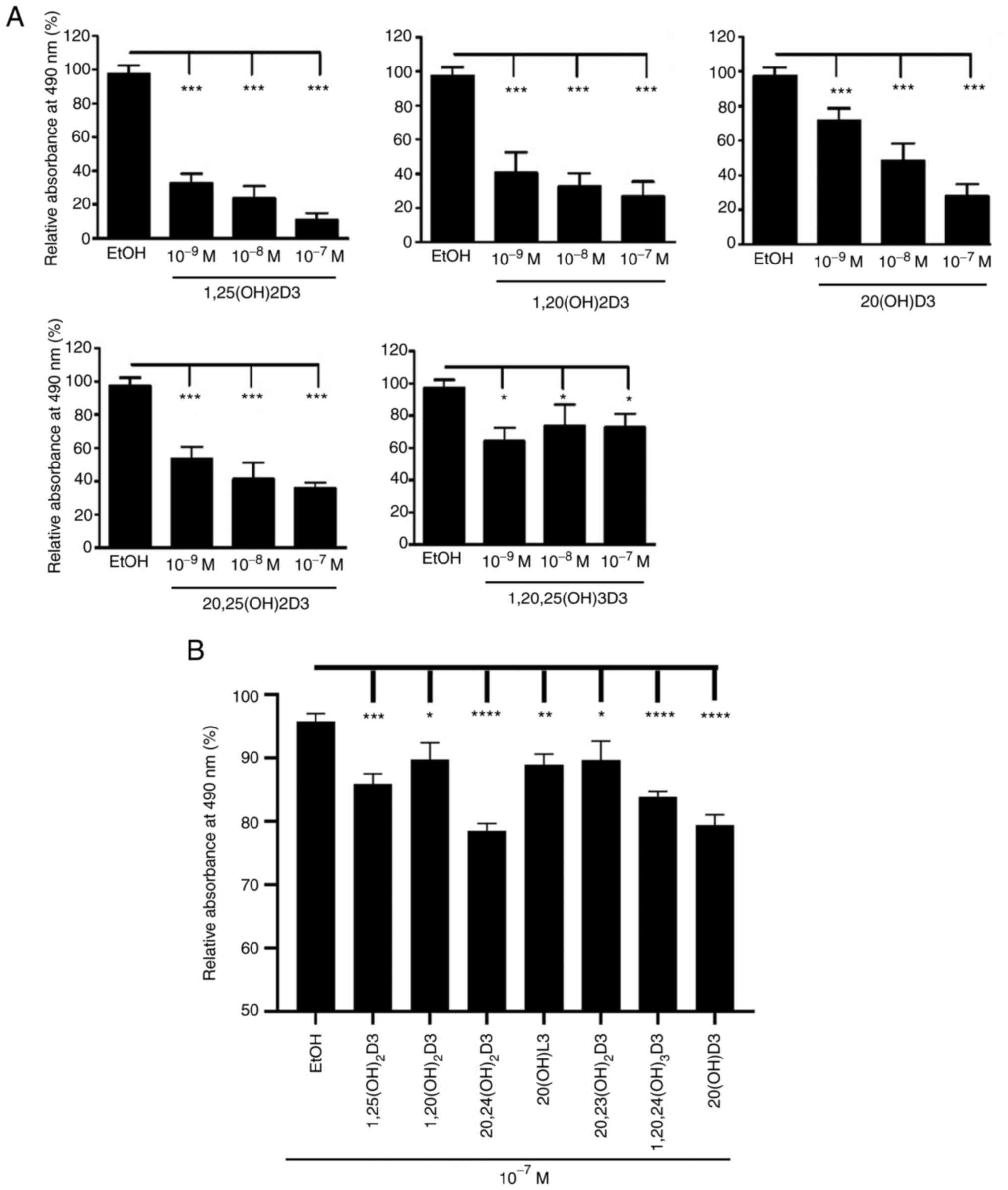 |
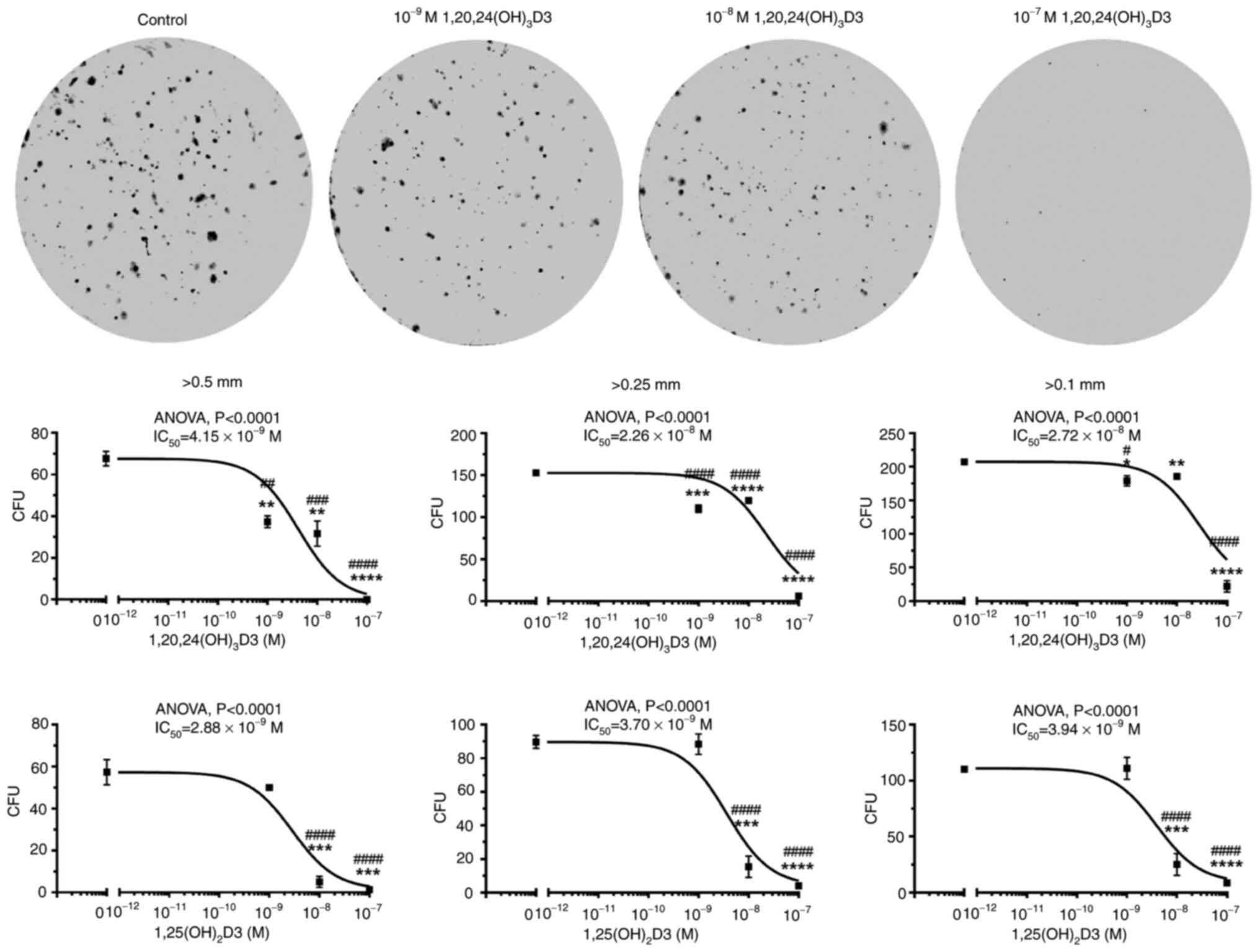 |
 |
 |
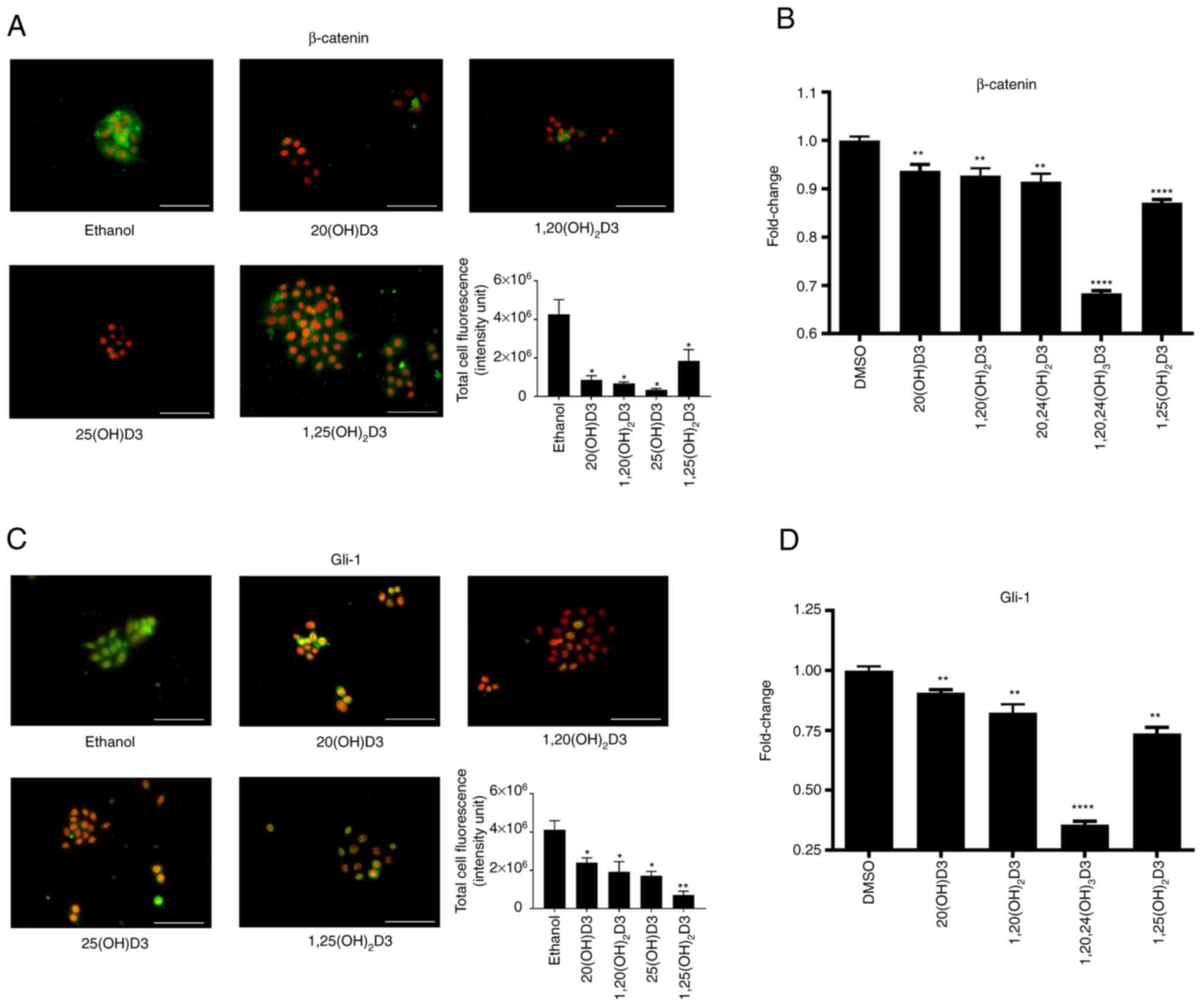 |
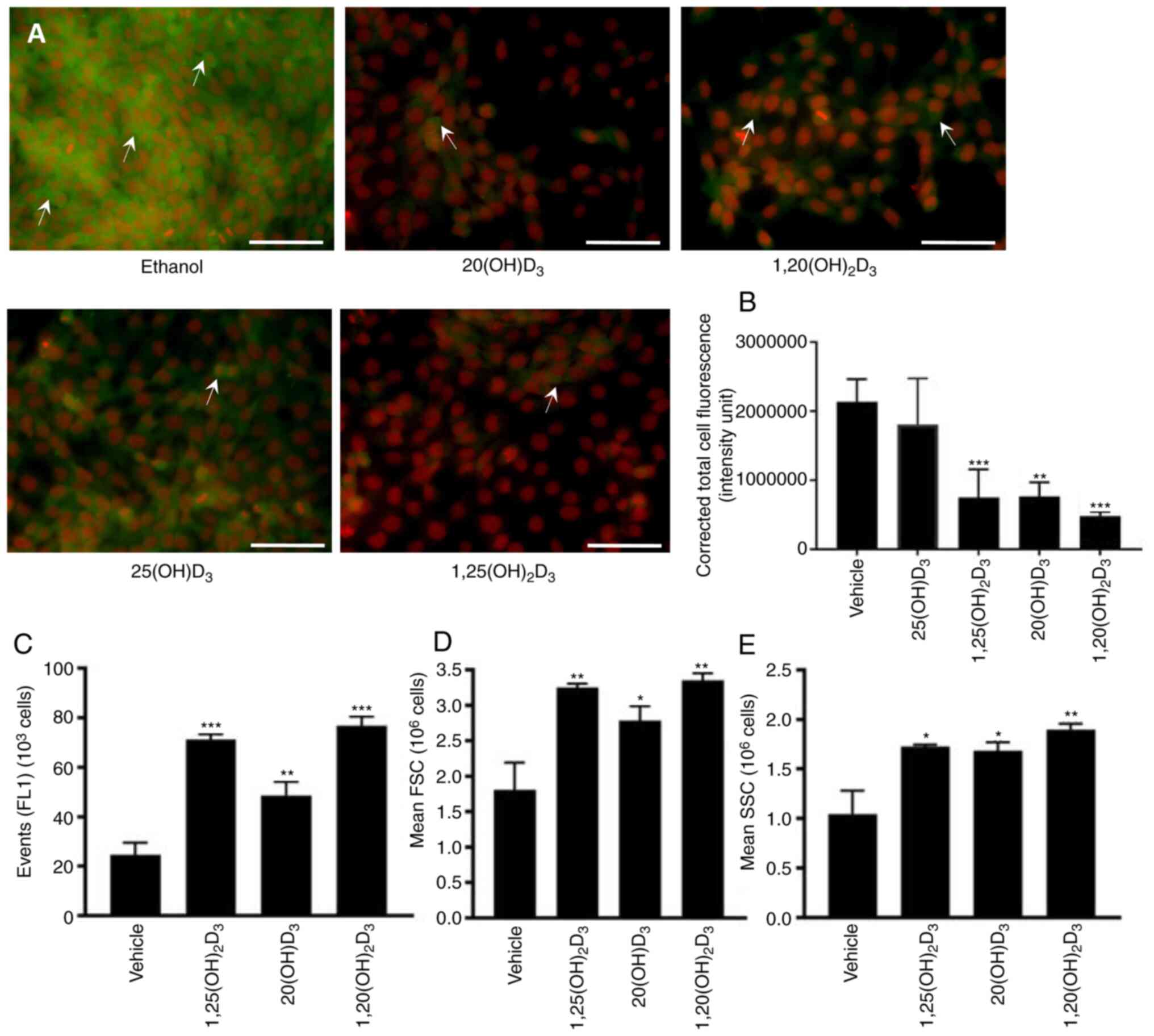 |
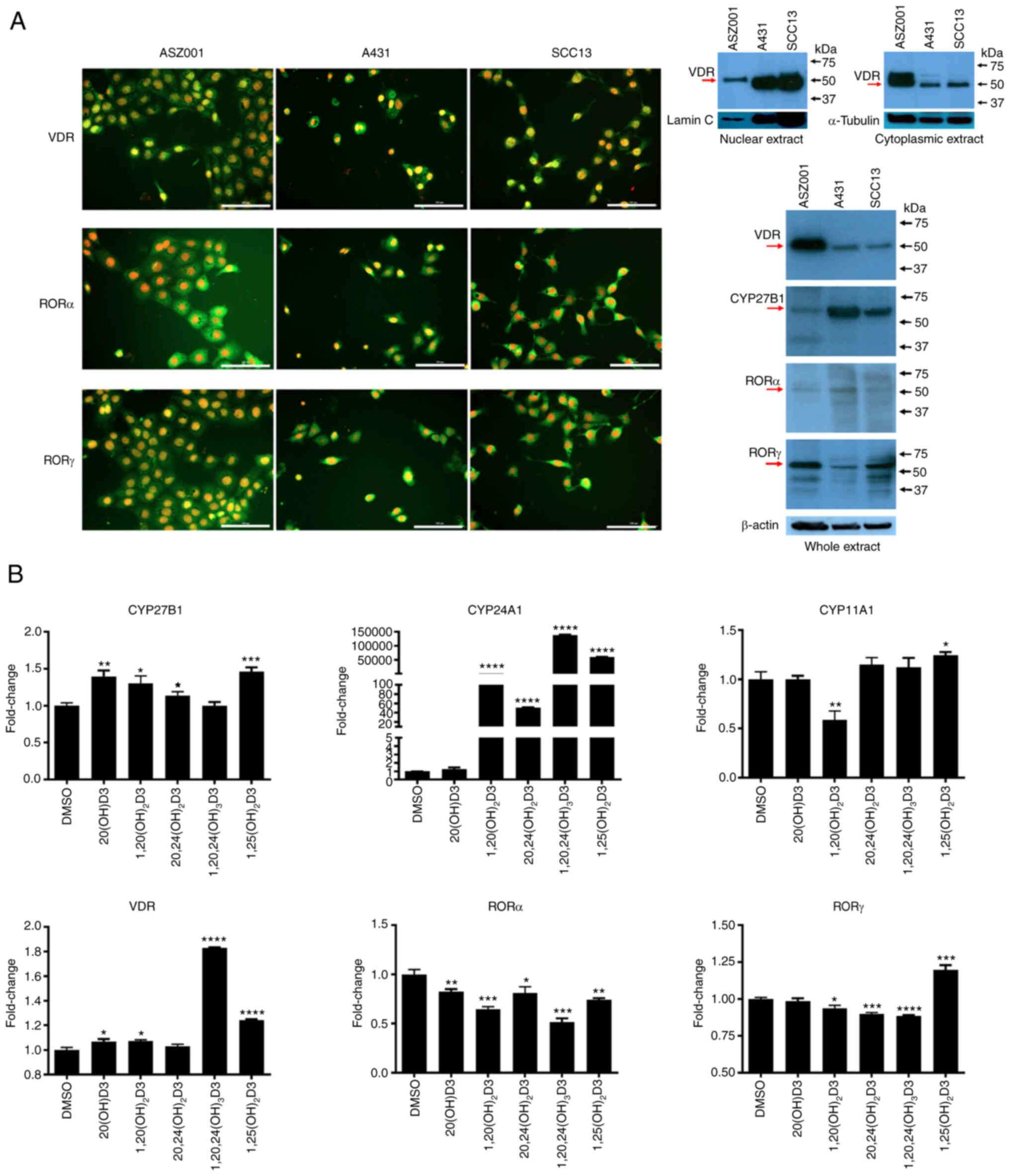 |
 |
 |
 |
|
Slominski AT, Zmijewski MA, Plonka PM, Szaflarski JP and Paus R: How UV light touches the brain and endocrine system through skin, and why. Endocrinology. 159:1992–2007. 2018. View Article : Google Scholar : PubMed/NCBI | |
|
Brash DE: UV signature mutations. Photochem Photobiol. 91:15–26. 2015. View Article : Google Scholar : | |
|
Wondrak GT: Let the sun shine in: Mechanisms and potential for therapeutics in skin photodamage. Curr Opin Investig Drugs. 8:390–400. 2007.PubMed/NCBI | |
|
D'Orazio J, Jarrett S, Amaro-Ortiz A and Scott T: UV radiation and the skin. Int J Mol Sci. 14:12222–12248. 2013. View Article : Google Scholar : PubMed/NCBI | |
|
Bickers DR and Athar M: Oxidative stress in the pathogenesis of skin disease. J Invest Dermatol. 126:2565–2575. 2006. View Article : Google Scholar : PubMed/NCBI | |
|
Slominski AT, Zmijewski MA, Semak I, Zbytek B, Pisarchik A, Li W, Zjawiony J and Tuckey RC: Cytochromes p450 and skin cancer: Role of local endocrine pathways. Anticancer Agents Med Chem. 14:77–96. 2014. View Article : Google Scholar | |
|
Athar M, Walsh SB, Kopelovich L and Elmets CA: Pathogenesis of nonmelanoma skin cancers in organ transplant recipients. Arch Biochem Biophys. 508:159–163. 2011. View Article : Google Scholar : PubMed/NCBI | |
|
Lo HL, Nakajima S, Ma L, Walter B, Yasui A, Ethell DW and Owen LB: Differential biologic effects of CPD and 6-4PP UV-induced DNA damage on the induction of apoptosis and cell-cycle arrest. BMC Cancer. 5:1352005. View Article : Google Scholar : PubMed/NCBI | |
|
Wondrak GT, Roberts MJ, Jacobson MK and Jacobson EL: 3-hydroxypyridine chromophores are endogenous sensitizers of photooxidative stress in human skin cells. J Biol Chem. 279:30009–30020. 2004. View Article : Google Scholar : PubMed/NCBI | |
|
Slominski AT, Zmijewski MA, Skobowiat C, Zbytek B, Slominski RM and Steketee JD: Sensing the environment: Regulation of local and global homeostasis by the skin's neuroendocrine system. Adv Anat Embryol Cell Biol. 212:v–vii. 1–115. 2012.PubMed/NCBI | |
|
Lim HW, Collins SAB, Resneck JS Jr, Bolognia JL, Hodge JA, Rohrer TA, Van Beek MJ, Margolis DJ, Sober AJ, Weinstock MA, et al: The burden of skin disease in the United States. J Am Acad Dermatol. 76:958–972.e2. 2017. View Article : Google Scholar : PubMed/NCBI | |
|
Carlson JA, Slominski A, Murphy MJ and Wilson V: Evidence of skin field cancerization. Field Cancerization: Basic Science and Clical Applications. Dakubo G: Nova Science Publishers Inc; pp. 317–369. 2011 | |
|
Holick MF: Vitamin D: A millenium perspective. J Cell Biochem. 88:296–307. 2003. View Article : Google Scholar : PubMed/NCBI | |
|
Holick MF, Tian XQ and Allen M: Evolutionary importance for the membrane enhancement of the production of vitamin D3 in the skin of poikilothermic animals. Proc Natl Acad Sci USA. 92:3124–3126. 1995. View Article : Google Scholar : PubMed/NCBI | |
|
Bikle DD: Vitamin D and the skin. J Bone Miner Metab. 28:117–130. 2010. View Article : Google Scholar : PubMed/NCBI | |
|
Holick MF: Vitamin D deficiency. N Engl J Med. 357:266–281. 2007. View Article : Google Scholar : PubMed/NCBI | |
|
Bikle DD: Vitamin D metabolism and function in the skin. Mol Cell Endocrinol. 347:80–89. 2011. View Article : Google Scholar : PubMed/NCBI | |
|
Plum LA and DeLuca HF: Vitamin D, disease and therapeutic opportunities. Nat Rev Drug Discov. 9:941–955. 2010. View Article : Google Scholar : PubMed/NCBI | |
|
Bikle DD: Vitamin D receptor, UVR, and skin cancer: A potential protective mechanism. J Invest Dermatol. 128:2357–2361. 2008. View Article : Google Scholar : PubMed/NCBI | |
|
Elias PM: Structure and function of the stratum corneum extracellular matrix. J Invest Dermatol. 132:2131–2133. 2012. View Article : Google Scholar : PubMed/NCBI | |
|
Bikle DD: Vitamin D: Newly discovered actions require reconsideration of physiologic requirements. Trends Endocrinol Metab. 21:375–384. 2010. View Article : Google Scholar : PubMed/NCBI | |
|
Indra AK, Castaneda E, Antal MC, Jiang M, Messaddeq N, Meng X, Loehr CV, Gariglio P, Kato S, Wahli W, et al: Malignant transformation of DMBA/TPA-induced papillomas and nevi in the skin of mice selectively lacking retinoid-X-receptor alpha in epidermal keratinocytes. J Invest Dermatol. 127:1250–1260. 2007. View Article : Google Scholar : PubMed/NCBI | |
|
Dixon KM, Tongkao-On W, Sequeira VB, Carter SE, Song EJ, Rybchyn MS, Gordon-Thomson C and Mason RS: Vitamin D and death by sunshine. Int J Mol Sci. 14:1964–1977. 2013. View Article : Google Scholar : PubMed/NCBI | |
|
Song EJ, Gordon-Thomson C, Cole L, Stern H, Halliday GM, Damian DL, Reeve VE and Mason RS: 1α,25-Dihydroxyvitamin D3 reduces several types of UV-induced DNA damage and contributes to photoprotection. J Steroid Biochem Mol Biol. 136:131–138. 2013. View Article : Google Scholar | |
|
Bikle DD, Elalieh H, Welsh J, Oh D, Cleaver J and Teichert A: Protective role of vitamin D signaling in skin cancer formation. J Steroid Biochem Mol Biol. 136:271–279. 2013. View Article : Google Scholar : | |
|
Demetriou SK, Ona-Vu K, Teichert AE, Cleaver JE, Bikle DD and Oh DH: Vitamin D receptor mediates DNA repair and is UV inducible in intact epidermis but not in cultured keratinocytes. J Invest Dermatol. 132:2097–2100. 2012. View Article : Google Scholar : PubMed/NCBI | |
|
Makarova A, Wang G, Dolorito JA, Kc S, Libove E and Epstein EH Jr: Vitamin D3 produced by skin exposure to UVR inhibits murine basal cell carcinoma carcinogenesis. J Invest Dermatol. 137:2613–2619. 2017. View Article : Google Scholar : PubMed/NCBI | |
|
Slominski AT, Li W, Kim TK, Semak I, Wang J, Zjawiony JK and Tuckey RC: Novel activities of CYP11A1 and their potential physiological significance. J Steroid Biochem Mol Biol. 151:25–37. 2015. View Article : Google Scholar | |
|
Slominski AT, Kim TK, Li W, Postlethwaite A, Tieu EW, Tang EKY and Tuckey RC: Detection of novel CYP11A1-derived secosteroids in the human epidermis and serum and pig adrenal gland. Sci Rep. 5:148752015. View Article : Google Scholar : PubMed/NCBI | |
|
Tuckey RC, Li W, Shehabi HZ, Janjetovic Z, Nguyen MN, Kim TK, Chen J, Howell DE, Benson HA, Sweatman T, et al: Production of 22-hydroxy metabolites of vitamin d3 by cytochrome p450scc (CYP11A1) and analysis of their biological activities on skin cells. Drug Metab Dispos. 39:1577–1588. 2011. View Article : Google Scholar : PubMed/NCBI | |
|
Slominski AT, Kim TK, Shehabi HZ, Semak I, Tang EK, Nguyen MN, Benson HA, Korik E, Janjetovic Z, Chen J, et al: In vivo evidence for a novel pathway of vitamin D3 metabolism initiated by P450scc and modified by CYP27B1. FASEB J. 26:3901–3915. 2012. View Article : Google Scholar : PubMed/NCBI | |
|
Tang EK, Chen J, Janjetovic Z, Tieu EW, Slominski AT, Li W and Tuckey RC: Hydroxylation of CYP11A1-derived products of vitamin D3 metabolism by human and mouse CYP27B1. Drug Metab Dispos. 41:1112–1124. 2013. View Article : Google Scholar : PubMed/NCBI | |
|
Slominski AT, Kim TK, Shehabi HZ, Tang EK, Benson HA, Semak I, Lin Z, Yates CR, Wang J, Li W and Tuckey RC: In vivo production of novel vitamin D2 hydroxy-derivatives by human placentas, epidermal keratinocytes, Caco-2 colon cells and the adrenal gland. Mol Cell Endocrinol. 383:181–192. 2014. View Article : Google Scholar : PubMed/NCBI | |
|
Slominski AT, Kim TK, Li W and Tuckey RC: Classical and non-classical metabolic transformation of vitamin D in dermal fibroblasts. Exp Dermatol. 25:231–232. 2016. View Article : Google Scholar : | |
|
Kim TK, Atigadda V, Brzeminski P, Fabisiak A, Tang EKY, Tuckey RC and Slominski AT: Detection of 7-dehydrocholesterol and vitamin D3 derivatives in honey. Molecules. 25:25832020. View Article : Google Scholar : | |
|
Slominski AT, Janjetovic Z, Kim TK, Wright AC, Grese LN, Riney SJ, Nguyen MN and Tuckey RC: Novel vitamin D hydroxyderivatives inhibit melanoma growth and show differential effects on normal melanocytes. Anticancer Res. 32:3733–3742. 2012.PubMed/NCBI | |
|
Wang J, Slominski A, Tuckey RC, Janjetovic Z, Kulkarni A, Chen J, Postlethwaite AE, Miller D and Li W: 20-Hydroxyvitamin D3 inhibits proliferation of cancer cells with high efficacy while being non-toxic. Anticancer Res. 32:739–746. 2012.PubMed/NCBI | |
|
Janjetovic Z, Brozyna AA, Tuckey RC, Kim TK, Nguyen MN, Jozwicki W, Pfeffer SR, Pfeffer LM and Slominski AT: High basal NF-κB activity in nonpigmented melanoma cells is associated with an enhanced sensitivity to vitamin D3 derivatives. Br J Cancer. 105:1874–1884. 2011. View Article : Google Scholar : PubMed/NCBI | |
|
Slominski AT, Janjetovic Z, Fuller BE, Zmijewski MA, Tuckey RC, Nguyen MN, Sweatman T, Li W, Zjawiony J, Miller D, et al: Products of vitamin D3 or 7-dehydrocholesterol metabolism by cytochrome P450scc show anti-leukemia effects, having low or absent calcemic activity. PLoS One. 5:e99072010. View Article : Google Scholar : PubMed/NCBI | |
|
Slominski A, Kim TK, Zmijewski MA, Janjetovic Z, Li W, Chen J, Kusniatsova EI, Semak I, Postlethwaite A, Miller DD, et al: Novel vitamin D photoproducts and their precursors in the skin. Dermatoendocrinol. 5:7–19. 2013. View Article : Google Scholar | |
|
Wasiewicz T, Szyszka P, Cichorek M, Janjetovic Z, Tuckey RC, Slominski AT and Zmijewski MA: Antitumor effects of vitamin D analogs on hamster and mouse melanoma cell lines in relation to melanin pigmentation. Int J Mol Sci. 16:6645–6667. 2015. View Article : Google Scholar : PubMed/NCBI | |
|
Slominski AT, Chaiprasongsuk A, Janjetovic Z, Kim TK, Stefan J, Slominski RM, Hanumanthu VS, Raman C, Qayyum S, Song Y, et al: Photoprotective properties of vitamin D and lumisterol hydroxyderivatives. Cell Biochem Biophys. 78:165–180. 2020. View Article : Google Scholar : PubMed/NCBI | |
|
Chaiprasongsuk A, Janjetovic Z, Kim TK, Tuckey RC, Li W, Raman C, Panich U and Slominski AT: CYP11A1-derived vitamin D3 products protect against UVB-induced inflammation and promote keratinocytes differentiation. Free Radic Biol Med. 155:87–98. 2020. View Article : Google Scholar : PubMed/NCBI | |
|
Chaiprasongsuk A, Janjetovic Z, Kim TK, Jarrett SG, D'Orazio JA, Holick MF, Tang EKY, Tuckey RC, Panich U, Li W and Slominski AT: Protective effects of novel derivatives of vitamin D3 and lumisterol against UVB-induced damage in human keratinocytes involve activation of Nrf2 and p53 defense mechanisms. Redox Biol. 24:1012062019. View Article : Google Scholar | |
|
Slominski AT, Janjetovic Z, Kim TK, Wasilewski P, Rosas S, Hanna S, Sayre RM, Dowdy JC, Li W and Tuckey RC: Novel non-calcemic secosteroids that are produced by human epidermal keratinocytes protect against solar radiation. J Steroid Biochem Mol Biol. 148:52–63. 2015. View Article : Google Scholar : PubMed/NCBI | |
|
Tongkao-on W, Carter S, Reeve VE, Dixon KM, Gordon-Thomson C, Halliday GM, Tuckey RC and Mason RS: CYP11A1 in skin: An alternative route to photoprotection by vitamin D compounds. J Steroid Biochem Mol Biol. 148:72–78. 2015. View Article : Google Scholar | |
|
Bikle D and Christakos S: New aspects of vitamin D metabolism and action-addressing the skin as source and target. Nat Rev Endocrinol. 16:234–252. 2020. View Article : Google Scholar : PubMed/NCBI | |
|
Bikle DD: Vitamin D: Newer concepts of its metabolism and function at the basic and clinical level. J Endocr Soc. 4:bvz0382020. View Article : Google Scholar : PubMed/NCBI | |
|
Reichrath J, Zouboulis CC, Vogt T and Holick MF: Targeting the vitamin D endocrine system (VDES) for the management of inflammatory and malignant skin diseases: An historical view and outlook. Rev Endocr Metab Disord. 17:405–417. 2016. View Article : Google Scholar : PubMed/NCBI | |
|
Carlberg C: Vitamin D genomics: From in vitro to in vivo. Front Endocrinol (Lausanne). 9:2502018. View Article : Google Scholar | |
|
Slominski AT, Kim TK, Janjetovic Z, Tuckey RC, Bieniek R, Yue J, Li W, Chen J, Nguyen MN, Tang EK, et al: 20-Hydroxyvitamin D2 is a noncalcemic analog of vitamin D with potent antiproliferative and prodifferentiation activities in normal and malignant cells. Am J Physiol Cell Physiol. 300:C526–C541. 2011. View Article : Google Scholar : | |
|
Kim TK, Wang J, Janjetovic Z, Chen J, Tuckey RC, Nguyen MN, Tang EK, Miller D, Li W and Slominski AT: Correlation between secosteroid-induced vitamin D receptor activity in melanoma cells and computer-modeled receptor binding strength. Mol Cell Endocrinol. 361:143–152. 2012. View Article : Google Scholar : PubMed/NCBI | |
|
Lin Z, Marepally SR, Goh ESY, Cheng CYS, Janjetovic Z, Kim TK, Miller DD, Postlethwaite AE, Slominski AT, Tuckey RC, et al: Investigation of 20S-hydroxyvitamin D analogs and their 1α-OH derivatives as potent vitamin D3 receptor agonists with anti-inflammatory activities. Sci Rep. 8:14782018. View Article : Google Scholar | |
|
Slominski AT, Kim TK, Takeda Y, Janjetovic Z, Brozyna AA, Skobowiat C, Wang J, Postlethwaite A, Li W, Tuckey RC and Jetten AM: RORα and ROR γ are expressed in human skin and serve as receptors for endogenously produced noncalcemic 20-hydroxy- and 20,23-dihydroxyvitamin D. FASEB J. 28:2775–2789. 2014. View Article : Google Scholar : PubMed/NCBI | |
|
Slominski AT, Kim TK, Hobrath JV, Oak ASW, Tang EKY, Tieu EW, Li W, Tuckey RC and Jetten AM: Endogenously produced nonclassical vitamin D hydroxy-metabolites act as 'biased' agonists on VDR and inverse agonists on RORα and RORγ. J Steroid Biochem Mol Biol. 173:42–56. 2017. View Article : Google Scholar | |
|
Janjetovic Z, Postlethwaite A, Kang HS, Kim TK, Tuckey RC, Crossman DK, Qayyum S, Jetten AM and Slominski AT: Antifibrogenic activities of CYP11A1-derived vitamin D3-hydroxyderivatives are dependent on RORγ. Endocrinology. 162:bqaa1982021. View Article : Google Scholar | |
|
Slominski AT, Kim TK, Janjetovic Z, Brożyna AA, Żmijewski MA, Xu H, Sutter TR, Tuckey RC, Jetten AM and Crossman DK: Differential and overlapping effects of 20,23(OH)2 D3 and 1,25(OH)2 D3 on gene expression in human epidermal keratinocytes: Identification of AhR as an alternative receptor for 20,23(OH)2 D3. Int J Mol Sci. 19:30722018. View Article : Google Scholar | |
|
Markiewicz A, Brożyna AA, Podgórska E, Elas M, Urbańska K, Jetten AM, Slominski AT, Jóźwicki W, Orłowska-Heitzman J, Dyduch G and Romanowska-Dixon B: Vitamin D receptors (VDR), hydroxylases CYP27B1 and CYP24A1 and retinoid-related orphan receptors (ROR) level in human uveal tract and ocular melanoma with different melanization levels. Sci Rep. 9:91422019. View Article : Google Scholar : PubMed/NCBI | |
|
Brożyna AA, Jóźwicki W, Skobowiat C, Jetten A and Slominski AT: RORα and RORγ expression inversely correlates with human melanoma progression. Oncotarget. 7:63261–63282. 2016. View Article : Google Scholar | |
|
Brożyna AA, Jóźwicki W, Jetten AM and Slominski AT: On the relationship between VDR, RORα and RORγ receptors expression and HIF1-α levels in human melanomas. Exp Dermatol. 28:1036–1043. 2019. View Article : Google Scholar | |
|
Brożyna AA, Hoffman RM and Slominski AT: Relevance of vitamin D in melanoma development, progression and therapy. Anticancer Res. 40:473–489. 2020. View Article : Google Scholar | |
|
Slominski AT, Brożyna AA, Zmijewski MA, Jóźwicki W, Jetten AM, Mason RS, Tuckey RC and Elmets CA: Vitamin D signaling and melanoma: Role of vitamin D and its receptors in melanoma progression and management. Lab Invest. 97:706–724. 2017. View Article : Google Scholar : PubMed/NCBI | |
|
Chen J, Wang J, Kim TK, Tieu EW, Tang EK, Lin Z, Kovacic D, Miller DD, Postlethwaite A, Tuckey RC, et al: Novel vitamin D analogs as potential therapeutics: Metabolism, toxicity profiling, and antiproliferative activity. Anticancer Res. 34:2153–2163. 2014.PubMed/NCBI | |
|
Slominski A, Janjetovic Z, Tuckey RC, Nguyen MN, Bhattacharya KG, Wang J, Li W, Jiao Y, Gu W, Brown M and Postlethwaite AE: 20S-Hydroxyvitamin D3, noncalcemic product of CYP11A1 action on vitamin D3, exhibits potent antifibrogenic activity in vivo. J Clin Endocrinol Metab. 98:E298–E303. 2013. View Article : Google Scholar : PubMed/NCBI | |
|
Carlberg C and Molnar F: Current status of vitamin D signaling and its therapeutic applications. Curr Top Med Chem. 12:528–547. 2012. View Article : Google Scholar : PubMed/NCBI | |
|
Gao Y, Zhou S, Luu S and Glowacki J: Megalin mediates 25-hydroxyvitamin D3 actions in human mesenchymal stem cells. FASEB J. 33:7684–7693. 2019. View Article : Google Scholar : PubMed/NCBI | |
|
Nykjaer A, Dragun D, Walther D, Vorum H, Jacobsen C, Herz J, Melsen F, Christensen EI and Willnow TE: An endocytic pathway essential for renal uptake and activation of the steroid 25-(OH) vitamin D3. Cell. 96:507–515. 1999. View Article : Google Scholar : PubMed/NCBI | |
|
Kaseda R, Hosojima M, Sato H and Saito A: Role of megalin and cubilin in the metabolism of vitamin D(3). Ther Apher Dial. 15(Suppl 1): S14–S17. 2011. View Article : Google Scholar | |
|
Slominski A, Semak I, Zjawiony J, Wortsman J, Li W, Szczesniewski A and Tuckey RC: The cytochrome P450scc system opens an alternate pathway of vitamin D3 metabolism. FEBS J. 272:4080–4090. 2005. View Article : Google Scholar : PubMed/NCBI | |
|
Tieu EW, Tang EK, Chen J, Li W, Nguyen MN, Janjetovic Z, Slominski A and Tuckey RC: Rat CYP24A1 acts on 20-hydroxyvitamin D(3) producing hydroxylated products with increased biological activity. Biochem Pharmacol. 84:1696–1704. 2012. View Article : Google Scholar : PubMed/NCBI | |
|
Tang EK, Li W, Janjetovic Z, Nguyen MN, Wang Z, Slominski A and Tuckey RC: Purified mouse CYP27B1 can hydroxylate 20,23-dihydroxyvitamin D3, producing 1alpha,20,23-trihydroxyvitamin D3, which has altered biological activity. Drug Metab Dispos. 38:1553–1559. 2010. View Article : Google Scholar : PubMed/NCBI | |
|
Tuckey RC, Li W, Zjawiony JK, Zmijewski MA, Nguyen MN, Sweatman T, Miller D and Slominski A: Pathways and products for the metabolism of vitamin D3 by cytochrome P450scc. FEBS J. 275:2585–2596. 2008. View Article : Google Scholar : PubMed/NCBI | |
|
Tieu EW, Li W, Chen J, Baldisseri DM, Slominski AT and Tuckey RC: Metabolism of cholesterol, vitamin D3 and 20-hydroxyvitamin D3 incorporated into phospholipid vesicles by human CYP27A1. J Steroid Biochem Mol Biol. 129:163–171. 2012. View Article : Google Scholar : PubMed/NCBI | |
|
Li W, Chen J, Janjetovic Z, Kim TK, Sweatman T, Lu Y, Zjawiony J, Tuckey RC, Miller D and Slominski A: Chemical synthesis of 20S-hydroxyvitamin D3, which shows antiproliferative activity. Steroids. 75:926–935. 2010. View Article : Google Scholar : PubMed/NCBI | |
|
Lin Z, Marepally SR, Ma D, Kim TK, Oak AS, Myers LK, Tuckey RC, Slominski AT, Miller DD and Li W: Synthesis and biological evaluation of vitamin D3 metabolite 20S,23S-dihydroxyvitamin D3 and Its 23R epimer. J Med Chem. 59:5102–5108. 2016. View Article : Google Scholar : PubMed/NCBI | |
|
Slominski A, Semak I, Wortsman J, Zjawiony J, Li W, Zbytek B and Tuckey RC: An alternative pathway of vitamin D metabolism. Cytochrome P450scc (CYP11A1)-mediated conversion to 20-hydroxyvitamin D2 and 17,20-dihydroxyvitamin D2. FEBS J. 273:2891–2901. 2006. View Article : Google Scholar : PubMed/NCBI | |
|
Tang JY, Xiao TZ, Oda Y, Chang KS, Shpall E, Wu A, So PL, Hebert J, Bikle D and Epstein EH Jr: Vitamin D3 inhibits hedgehog signaling and proliferation in murine basal cell carcinomas. Cancer Prev Res (Phila). 4:744–751. 2011. View Article : Google Scholar | |
|
So PL, Langston AW, Daniallinia N, Hebert JL, Fujimoto MA, Khaimskiy Y, Aszterbaum M and Epstein EH Jr: Long-term establishment, characterization and manipulation of cell lines from mouse basal cell carcinoma tumors. Exp Dermatol. 15:742–750. 2006. View Article : Google Scholar : PubMed/NCBI | |
|
Chaudhary SC, Singh T, Talwelkar SS, Srivastava RK, Arumugam A, Weng Z, Elmets CA, Afaq F, Kopelovich L and Athar M: Erb-041, an estrogen receptor-β agonist, inhibits skin photocarcinogenesis in SKH-1 hairless mice by downregulating the WNT signaling pathway. Cancer Prev Res (Phila). 7:186–198. 2014. View Article : Google Scholar | |
|
Oak ASW, Bocheva G, Kim TK, Brożyna AA, Janjetovic Z, Athar M, Tuckey RC and Slominski AT: Noncalcemic vitamin D hydroxyderivatives inhibit human oral squamous cell carcinoma and down-regulate hedgehog and WNT/β-catenin pathways. Anticancer Res. 40:2467–2474. 2020. View Article : Google Scholar : PubMed/NCBI | |
|
Brożyna AA, Kim TK, Zabłocka M, Jóźwicki W, Yue J, Tuckey RC, Jetten AM and Slominski AT: Association among vitamin D, retinoic acid-related orphan receptors, and vitamin D hydroxyderivatives in ovarian cancer. Nutrients. 12:35412020. View Article : Google Scholar | |
|
Brozyna AA, VanMiddlesworth L and Slominski AT: Inhibition of melanogenesis as a radiation sensitizer for melanoma therapy. Int J Cancer. 123:1448–1456. 2008. View Article : Google Scholar : PubMed/NCBI | |
|
Slominski AT, Brożyna AA, Zmijewski MA, Janjetovic Z, Kim TK, Slominski RM, Tuckey RC, Mason RS, Jetten AM, Guroji P, et al: The role of classical and novel forms of vitamin D in the pathogenesis and progression of nonmelanoma skin cancers. Adv Exp Med Biol. 1268:257–283. 2020. View Article : Google Scholar : PubMed/NCBI | |
|
Brożyna AA, Żmijewski MA, Linowiecka K, Kim TK, Slominski RM and Slominski AT: Disturbed expression of vitamin D and retinoic acid-related orphan receptors α and γ and of megalin in inflammatory skin diseases. Exp Dermatol. 31:781–788. 2022. View Article : Google Scholar | |
|
Riker AI, Enkemann SA, Fodstad O, Liu S, Ren S, Morris C, Xi Y, Howell P, Metge B, Samant RS, et al: The gene expression profiles of primary and metastatic melanoma yields a transition point of tumor progression and metastasis. BMC Med Genomics. 1:132008. View Article : Google Scholar : PubMed/NCBI | |
|
Cunningham TJ, Tabacchi M, Eliane JP, Tuchayi SM, Manivasagam S, Mirzaalian H, Turkoz A, Kopan R, Schaffer A, Saavedra AP, et al: Randomized trial of calcipotriol combined with 5-fluorouracil for skin cancer precursor immunotherapy. J Clin Invest. 127:106–116. 2017. View Article : Google Scholar : | |
|
Hadden MK: Hedgehog and vitamin D signaling pathways in development and disease. Vitam Horm. 100:231–253. 2016. View Article : Google Scholar : PubMed/NCBI | |
|
Uhmann A, Niemann H, Lammering B, Henkel C, Hess I, Nitzki F, Fritsch A, Prüfer N, Rosenberger A, Dullin C, et al: Antitumoral effects of calcitriol in basal cell carcinomas involve inhibition of hedgehog signaling and induction of vitamin D receptor signaling and differentiation. Mol Cancer Ther. 10:2179–2188. 2011. View Article : Google Scholar : PubMed/NCBI | |
|
Dixon KM, Norman AW, Sequeira VB, Mohan R, Rybchyn MS, Reeve VE, Halliday GM and Mason RS: 1α,25(OH)2-vitamin D and a nongenomic vitamin D analogue inhibit ultraviolet radiation-induced skin carcinogenesis. Cancer Prev Res (Phila). 4:1485–1494. 2011. View Article : Google Scholar | |
|
Reichrath J, Rafi L, Rech M, Mitschele T, Meineke V, Gartner BC, Tilgen W and Holick MF: Analysis of the vitamin D system in cutaneous squamous cell carcinomas. J Cutan Pathol. 31:224–231. 2004. View Article : Google Scholar : PubMed/NCBI | |
|
Bikle DD: Vitamin D and the skin: Physiology and pathophysiology. Rev Endocr Metab Disord. 13:3–19. 2012. View Article : Google Scholar | |
|
Dixon KM, Sequeira VB, Deo SS, Mohan R, Posner GH and Mason RS: Differential photoprotective effects of 1,25-dihydroxyvitamin D3 and a low calcaemic deltanoid. Photochem Photobiol Sci. 11:1825–1830. 2012. View Article : Google Scholar : PubMed/NCBI | |
|
Zbytek B, Janjetovic Z, Tuckey RC, Zmijewski MA, Sweatman TW, Jones E, Nguyen MN and Slominski AT: 20-Hydroxyvitamin D3, a product of vitamin D3 hydroxylation by cytochrome P450scc, stimulates keratinocyte differentiation. J Invest Dermatol. 128:2271–2280. 2008. View Article : Google Scholar : PubMed/NCBI | |
|
Podgorska E, Kim TK, Janjetovic Z, Urbanska K, Tuckey RC, Bae S and Slominski AT: Knocking out the vitamin D receptor enhances malignancy and decreases responsiveness to vitamin D3 hydroxyderivatives in human melanoma cells. Cancers (Basel). 13:31112021. View Article : Google Scholar | |
|
Slominski AT, Brożyna AA, Skobowiat C, Zmijewski MA, Kim TK, Janjetovic Z, Oak AS, Jozwicki W, Jetten AM, Mason RS, et al: On the role of classical and novel forms of vitamin D in melanoma progression and management. J Steroid Biochem Mol Biol. 177:159–170. 2018. View Article : Google Scholar : | |
|
Skobowiat C, Oak AS, Kim TK, Yang CH, Pfeffer LM, Tuckey RC and Slominski AT: Noncalcemic 20-hydroxyvitamin D3 inhibits human melanoma growth in in vitro and in vivo models. Oncotarget. 8:9823–9834. 2017. View Article : Google Scholar : PubMed/NCBI | |
|
Jenkinson C: The vitamin D metabolome: An update on analysis and function. Cell Biochem Funct. 37:408–423. 2019. View Article : Google Scholar : PubMed/NCBI | |
|
Jenkinson C, Desai R, Slominski AT, Tuckey RC, Hewison M and Handelsman DJ: Simultaneous measurement of 13 circulating vitamin D3 and D2 mono and dihydroxy metabolites using liquid chromatography mass spectrometry. Clin Chem Lab Med. 59:1642–1652. 2021. View Article : Google Scholar : PubMed/NCBI | |
|
Carlberg C and Muñoz A: An update on vitamin D signaling and cancer. Semin Cancer Biol. 79:217–230. 2022. View Article : Google Scholar | |
|
Zmijewski MA and Carlberg C: Vitamin D receptor(s): In the nucleus but also at membranes? Exp Dermatol. 29:876–884. 2020. View Article : Google Scholar : PubMed/NCBI | |
|
Tuckey RC, Cheng CYS and Slominski AT: The serum vitamin D metabolome: What we know and what is still to discover. J Steroid Biochem Mol Biol. 186:4–21. 2019. View Article : Google Scholar : | |
|
Christakos S, Li S, De La Cruz J and Bikle DD: New developments in our understanding of vitamin metabolism, action and treatment. Metabolism. 98:112–120. 2019. View Article : Google Scholar : PubMed/NCBI | |
|
Christakos S, Dhawan P, Verstuyf A, Verlinden L and Carmeliet G: Vitamin D: Metabolism, molecular mechanism of action, and pleiotropic effects. Physiol Rev. 96:365–408. 2016. View Article : Google Scholar : | |
|
Medeiros JFP, de Oliveira Borges MV, Soares AA, dos Santos JC, de Oliveira ABB, da Costa CHB, Cruz MS, Bortolin RH, de Freitas RCC, Dantas PMS, et al: The impact of vitamin D supplementation on VDR gene expression and body composition in monozygotic twins: Randomized controlled trial. Sci Rep. 10:119432020. View Article : Google Scholar : PubMed/NCBI | |
|
Hu L, Bikle DD and Oda Y: Reciprocal role of vitamin D receptor on β-catenin regulated keratinocyte proliferation and differentiation. J Steroid Biochem Mol Biol. 144(Pt A): 237–241. 2014. View Article : Google Scholar | |
|
Reichrath J, Kamradt J, Zhu XH, Kong XF, Tilgen W and Holick MF: Analysis of 1,25-dihydroxyvitamin D(3) receptors (VDR) in basal cell carcinomas. Am J Pathol. 155:583–589. 1999. View Article : Google Scholar : PubMed/NCBI | |
|
Bikle DD, Ng D, Oda Y, Hanley K, Feingold K and Xie Z: The vitamin D response element of the involucrin gene mediates its regulation by 1,25-dihydroxyvitamin D3. J Invest Dermatol. 119:1109–1113. 2002. View Article : Google Scholar : PubMed/NCBI | |
|
Janjetovic Z, Tuckey RC, Nguyen MN, Thorpe EM Jr and Slominski AT: 20,23-dihydroxyvitamin D3, novel P450scc product, stimulates differentiation and inhibits proliferation and NF-kappaB activity in human keratinocytes. J Cell Physiol. 223:36–48. 2010. | |
|
Grund-Gröschke S, Stockmaier G and Aberger F: Hedgehog/GLI signaling in tumor immunity-new therapeutic opportunities and clinical implications. Cell Commun Signal. 17:1722019. View Article : Google Scholar | |
|
Shang S, Hua F and Hu ZW: The regulation of β-catenin activity and function in cancer: Therapeutic opportunities. Oncotarget. 8:33972–33989. 2017. View Article : Google Scholar : PubMed/NCBI | |
|
Torezan L, Grinblat B, Haedersdal M, Valente N, Festa-Neto C and Szeimies RM: A randomized split-scalp study comparing calcipotriol-assisted methyl aminolaevulinate photodynamic therapy (MAL-PDT) with conventional MAL-PDT for the treatment of actinic keratosis. Br J Dermatol. 179:829–835. 2018. View Article : Google Scholar : PubMed/NCBI | |
|
Slominski AT, Kim TK, Qayyum S, Song Y, Janjetovic Z, Oak ASW, Slominski R M, Raman C, Stefan J, Mier-Aguilar CA, et al: Vitamin D and lumisterol derivatives can act on liver X receptors (LXRs). Sci Rep. 11:80022021. View Article : Google Scholar : PubMed/NCBI |









